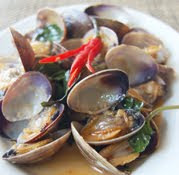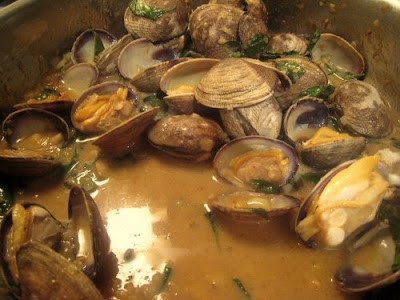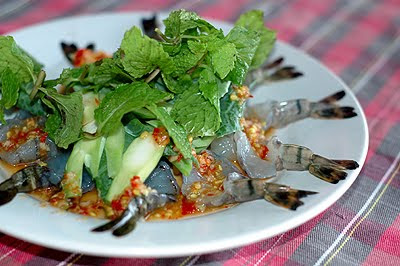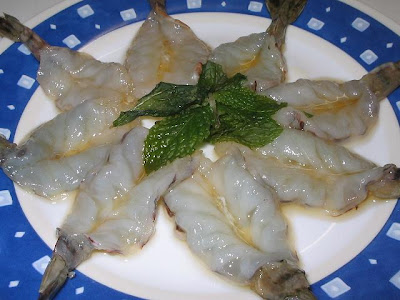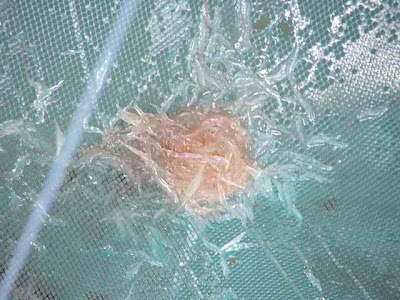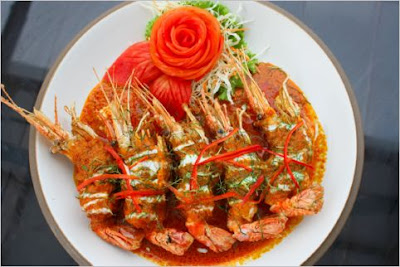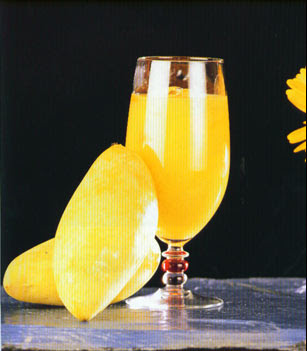 bai horapa ใบโหระพา Sweet Thai Basil
bai horapa ใบโหระพา Sweet Thai BasilTastes rather like anise, looks like European sweet basil, and is used in red and green curries.
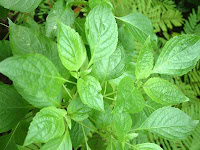 bai graprow ใบกระเพรา Thai Holy Basil Leaf
bai graprow ใบกระเพรา Thai Holy Basil LeafOcimum Sanctum. Green with purple reddish tinged leaves, holy basil has a clove-like taste.
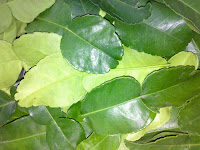 bai magroot ใบมะกรูด Kaffir Lime Leaf
bai magroot ใบมะกรูด Kaffir Lime LeafSee pew magroot
 buap liam บวบเหลื่ยม Sponge gourd, angle gourd, angled luffa
buap liam บวบเหลื่ยม Sponge gourd, angle gourd, angled luffaAlso known as angle gourd, angled luffa, or Chinese okra. Fruits have raised ridges running from end to end, resembling okra. The ridged fruit is 1-2 ft. long and 2 inches across and is lighter than the Smooth Skin Luffa. This variety is very popular for cooking use in China and Vietnam. Flesh is very tender and delicious.
 fak thong ฟักทอง Pumpkin
fak thong ฟักทอง PumpkinCucurbita moschata, also known as Cushaw, Butternut Squash, or Winter Squash.
 kuichai กุยช่าย Chinese Chive
kuichai กุยช่าย Chinese ChiveAllium tuberosum, also known as garlic chives, the flavor is more like garlic than chives, though much milder. Both leaves and the stalks of the flowers are used as a flavoring similarly to chives, green onions or garlic and are used as a stir fry ingredient. In China, they are often used to make dumplings with a combination of egg, shrimp and pork. The flowers may also be used as a spice.
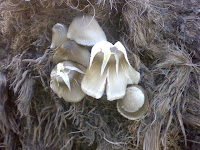 het fang เห็ดฟาง Straw Mushroom
het fang เห็ดฟาง Straw MushroomVolvariella volvacea
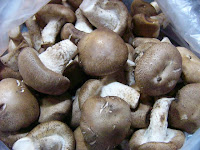 het hom เห็ดหอม Shiitake Mushroom
het hom เห็ดหอม Shiitake MushroomLentinus edodes, also known as Chinese Mushrooms or Japanese Black Mushrooms. Shiitake mushrooms have a pale brown to dark reddish brown cap that is generally two to four inches wide. The young mushrooms have an edge rolled inward, which nearly flattens out with age. The stems are tough and fibrous and are generally detached and discarded. The cap has creamy white gills on its underside and its flesh is firm and white. The mushroom grows in clusters on hardwood, such as oak, chestnut and beech. The flesh is meaty textured with a rich, smoky flavor and goes well with all foods. These mushrooms are supposed to be good for baby’s cartilage.
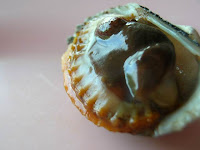 hoi kraeng หอยแครง Cockle
hoi kraeng หอยแครง CockleAnadara granosa and Anadara nodifera. Also known as arc shell and blood cockle.
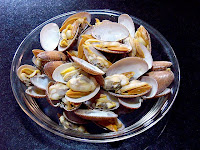 hoi lai หอยลาย Clam
hoi lai หอยลาย ClamPaphia undulata, Undulated Surf Clam.
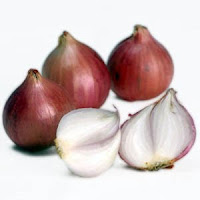 hom daeng หอมแดง Red Shallots
hom daeng หอมแดง Red Shallots %2520of%2520herbs_clip_image002.jpg) kha ข่า Galangal
kha ข่า GalangalAlphinia galangal, is a larger and lighter-colored relative of ginger and has its own distinctive taste.
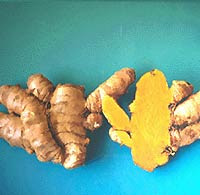 kha min ขมิ้น Tumeric
kha min ขมิ้น TumericCurcuma longa, is a small ginger with brown rhizones. Inside the flesh is bright orange
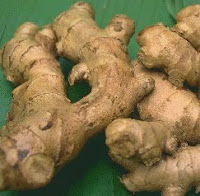 khing ขิง Ginger
khing ขิง GingerZingiber officinale, grows from underground stems, or rhisome. Mature ginger stems are buff-colored; young or fresh ginger, king awn ขิงอ่อน, is white and is eaten fresh and pickled, as well as cooked.
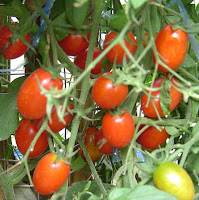 ma khuea thet มะเขือเทศ Tomato
ma khuea thet มะเขือเทศ Tomato 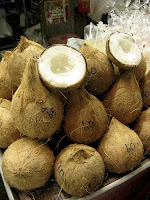 ma prao มะพร้าว Coconut
ma prao มะพร้าว Coconut 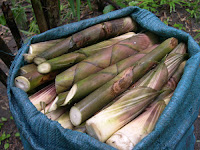 no mai หน่อไม้ Bamboo Shoots
no mai หน่อไม้ Bamboo Shoots  Phak bung thai ผักบุ้งไทย Thai Water Morning Glory, Thai Water Convolvulus Ipomoea Aquatica. Thai water convovulus is an annual aquatic plant that spreads its stems on the water surface. The stem is succulent, crisp, green in color and segmented. The leaves are heart-shaped and commonly used in kaeng teop, sour spicy soups, fried with pork, used in yen ta fo and eaten as a fresh vegetable with nam prik.
Phak bung thai ผักบุ้งไทย Thai Water Morning Glory, Thai Water Convolvulus Ipomoea Aquatica. Thai water convovulus is an annual aquatic plant that spreads its stems on the water surface. The stem is succulent, crisp, green in color and segmented. The leaves are heart-shaped and commonly used in kaeng teop, sour spicy soups, fried with pork, used in yen ta fo and eaten as a fresh vegetable with nam prik. 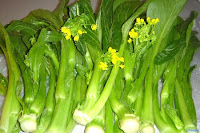
phak guang tungผักกวางตุ้ง Cantonese Vegetable
Literally, “Guangdong vegetable”, Guangdong is located in Canton, Chinese. Also know as yao choy, yu choi, edible rape, green choy sum or sarsun (in India). It has long stalks, skinny leaves, and yellow flowers. It is a little more bitter than bok choy
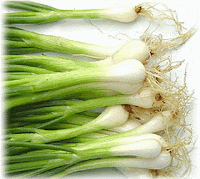 ton hom ต้นหอม Green Onions, Spring Onions
ton hom ต้นหอม Green Onions, Spring Onions 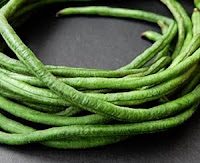 tua phak yao ถั่วฝักยาว Long Beans, Yard
tua phak yao ถั่วฝักยาว Long Beans, Yard  tua ngok ถั่วงอก Bean Sprouts
tua ngok ถั่วงอก Bean Sprouts 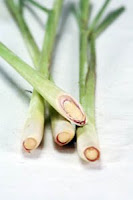
ta khrai ตะไคร้ Lemongrass
Cymbopgon citratus, is an aromatic grey-green grass
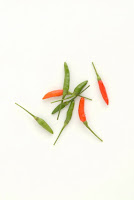
phrik ki nu พริกขี้หนู Thai chiles
Capsicum minimum, small red or green fiery “bird” or mouse dropping chile.
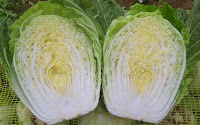 phak kat chin ผักกาดจีน Chinese White Cabbage
phak kat chin ผักกาดจีน Chinese White CabbageBrassica pekinensis also called ผักกาดขาว, pak gaat kao. The leaves of Chinese cabage are light green and crinkly. Chinese cabbage is commonly used for soups, fried, or eaten as a raw vegetable with laab or nam prik.
 phak kat ผักกาด Lettuce
phak kat ผักกาด LettuceI’ve also seen lettuce
Brassica alboglabra, also known as as gai lohn, kai lan, and Chinese kale. The plant resembles regular broccoli, although the leaves appear to be a bit broader and the stems somewhat longer than broccoli. The flowers form first into diminutive heads and then elongate rapidly into flower stalks bearing yellow flowers.
 tua pu ถั่วพู Wing Beans
tua pu ถั่วพู Wing Beans Solanum torvum, small pea-sized green eggplants with smooth skin. The young fruit is eaten as a fresh vegetable, put in nam prik, or used in curry, green curry, and kaeng kai.
Literally “Laotian Cilantro“. Commonly seen with street food vendors to add a taste to soups.
Perna viridis, green mussel, also called hoi maeng phu หอยแมงภู่, in Thai.
Eryngium Foetidum. Stink Weed is an annual plant with a short clumpy stem. The leaves are long-shaped, about 3 to 4 inches and 1/2 inch wide with dark green, with jagged edges. They are smooth and have a pleasant fragrance and a characteristic slightly sour taste. The leaves are eaten as a fresh vegetable and used to give fragrance to foods.
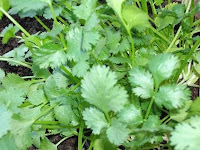 phak chi ผักชี Cilantro
phak chi ผักชี CilantroCoriandrum sativum, is of the parsley family. The leaves and stems are eaten fresh and used frequently as a garnish. The root and the seeds are ingredients in many dishes.
